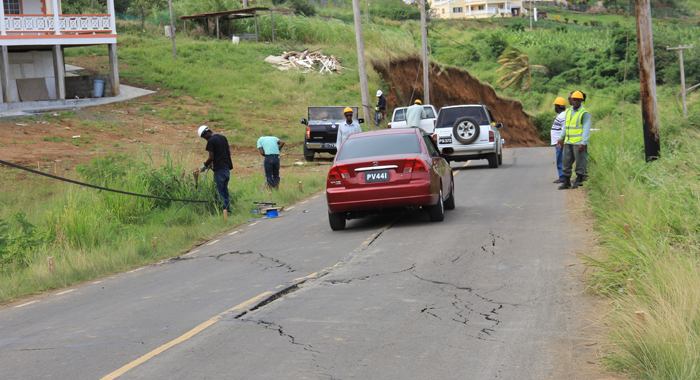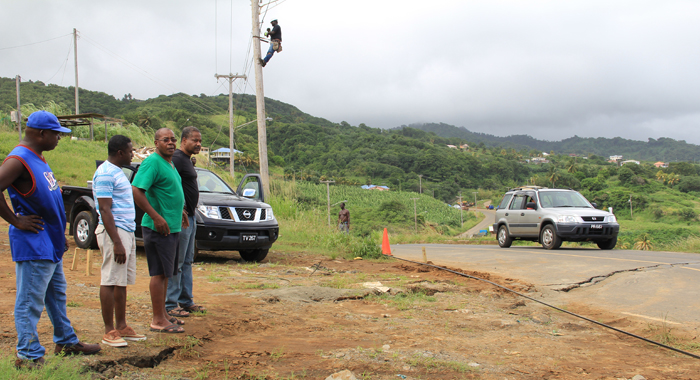The government has closed the section of the Windward Highway just outside the Argyle International Airport construction site where the road sunk some 15 inches between Friday and Sunday morning.
Minister of State in the Ministry of Transport and Works, Sen. Julian Francis, said on radio Sunday evening that the road will remain closed for three days to allow for the completion of a bypass, work on which began Sunday morning.
The bypass road is expected to open on Thursday.
“The situation there is deterioration, in that the depression in the road is getting more enhanced and becoming very uncomfortable for motorists, and, for the safety also of travellers on highway, we consider it best that we close that highway,” he said in a broadcast around 4 p.m., in which the announced that the closure will come into effected at 7 p.m.
“It is not an extended period of time. It is three days and it is better to be safe than to be sorry. The vehicles passing across that highway in its present condition put more pressure on the road surface and the slippage and it also gets in the way of the corrective work,” Francis said in the broadcast, in which he also outlined the alternative routes.
The cracks have gotten progressively worse, and on Saturday, VINLEC, LIME and FLOW removed their electricity and telecommunications infrastructure to the opposite side of the road.
Francis said that the cause(s) of the depressions would be better explained by engineers. He, however, said engineers had informed him that the groundwater and the fill in the area were the cause of the slippage, where the highway was built around seven years ago.
Read also: Officials mull response to earth movement along Argyle main road
“And as the land slips at the bottom, the road depresses. And, between Friday afternoon, Friday midday when it was picked up and this morning (Sunday), it has sunken considerably — as much as 15 inches, and we have not had any heavy showers. So we are just not taking any further chances with it, just in case we get any heavy showers, it may just deteriorate a little bit faster.”
He said that ahead of the decision to close the road completely, it had been reduced from two to one lane of traffic. He added that the engineers needed space to build the bypass, which will require drainage as well.
“And because of the slippage in the area, the water will have to be diverted in a different direction across the Windward Highway.”
Francs sad he is convinced that the engineers and the crew from Argyle International Airport will be able to pave the bypass with asphalt by Wednesday night.
“So by Thursday morning, I trust that we can reopen that road using the bypass,” he said.

Alternative routes
Vehicles travelling away from Kingstown will turn left at Mt Pleasant, drive up Calder Road, up to Crick Corner, through Mesopotamia, though Yambou, and exit at Peruvian Vale and continue on the Windward Highway.
Persons familiar with Akers Road, can take the shortcut there that exits onto the Windward Highway and is faster than going to Peruvian Vale, Francis said.
He, however, warned that although the surface is good and can be used, it is a narrower road, and has no streetlights.
Traffic into Kingstown will turn right at Peruvian Vale and follow the reverse route.
However, on getting to Crick Corner, they will have a choice to go up Belmont, onto the Fair Hall road and exit in Calliaqua, or turn left at Crick Corner, go down Calder and exit at Mt Pleasant and continue into Kingstown.
Francis, however, said that the road is not in the best shape.
“There are some potholes on that road. I drove it through today again and it is not as bad as I thought, but I would want you to exercise extreme caution in using that route.”
He said that the road accommodates two-way traffic all the time but with the diversion, there will be more vehicles, and asked person not to park their vehicles on the road.
Francis said there are utility lines in the area of the damaged road at Argyle and the Central Water and Sewerage Authority (CWSA) will be putting in a diversion of their main line to facilitate the line from Jennings into Diamond.
He said the CWSA intends to link the 8-inch water pipe back to the Calder storage and make sure that they maintain the water supply.

30 minutes more commute
He noted that commuters will have longer travelling times and advised that persons set out 30 minutes earlier than usual.
Francis appealed especially to minibus drivers, saying that the next three days are going to be “trying times”, and asked them to drive with extreme caution.
“The road is not in the condition of the Windward Highway. The road through Peruvian Vale coming down Jack Hill is very bumpy, and while we had done some corrective works there some time ago, earth movement in that area, over the years that I have known Jack Hill, has always been a problem. As it exists now, it is not a road for speeding,” Francis said.
He further announced that he has asked the Roads Bridges and General Services Authority (BRAGSA) to delay the deployment of road cleaning gangs in the area of the damaged road in Argyle.
“Because of what’s happening there, we thought it best, for public safety and to give the engineers time to do the bypass properly and get the drainage across the road, … to close the road off,” he said.
The diversion will be inconvenient for some residents of Mt Pleasant, because they will have to go up Calder, on to Crick Corner, along Akers Road and back down, and across the airport to get to their residents, Francis said.
He said Mt Pleasant residents who are familiar with the Peruvian Vale road can use that route.
“So, it is a long roundabout for you, but again, I appeal to you for understanding and cooperation in the matter; … it is unavoidable,” Francis said.
He said the police will be putting up signs, will put drum in place and will put proper signage to indicate where Crick Corner and Akers Road are, and arrows at Peruvian Vale.
He said these will be in place by today, Monday.






wow clearly another engineering issue. our professionals really need to be more effective get out and get on top of things in whatever field you are in. fingers will be pointed at the government but isn’t it time we start scrutinizing our professionals?
look at the Clare valley housing project, there were engineers on that job and they have a responsibility.
lets hear from the engineering and project management here.
Francis, why do you like to down-play situations like that? Fair Hall road is extremely bad. I consider that bypass extremely important to the windward side of the island so some effort should be made to keep it as good as the main high way. Clayton Burgin is the representative for East St. George and he does nothing as far as representing the constituency is concerned. Even Choppins where he lives is being neglected in a big way. I am taking this opportunity to ask Mr. Burgin to step up and redeem himself.
Can’t this MNU Administration do anything right?
Typically, even the best of us have a 5% failure rate. But this crew appear to have a 95% failure rate.
I used to be gracious and praise the construction of poor people’s homes. Then we found out those were poor quality structures which were falling apart and they were not for the poor but middle class and these homes were a scam on the owners.
The airport strip itself is enough of a failure that I expect it will not get the OK for US or UK planes to land. Maybe we can go to Caracas and risk our lives from there to Argyle.
WHAT A MESS?
The comments attributed to Sen. Francis is the perfect example of why we should leave explanations to the professionals.
What does the following mean? – The situation there is deterioration, in that the depression in the road is getting more enhanced …….”. There isn’t deterioration, the road/pavement has failed as a result of the subgrade. Exactly how does one enhance a depression?
The following statement is even more amazing – “He, however, said engineers had informed him that the groundwater and the fill in the area were the cause of the slippage, where the highway was built around seven years ago.”
This after all the main highway to our pending international airport, yet there are no visible shoulders or even drainage paths, culverts, much less a drainage channel. Grass is growing up the edges of the asphalt pavement, amazing. I’m sure this does wonders for drainage and in reducing ponding along the edges of the pavement. That had to be a typo that that road was built 7 years ago, planning and vision at its best. Who would have thought that water flows through soils.
The pictures show a failure that resulted from an overloading of the pavement; i.e. the pavement was under designed for the traffic that it is subjected to. The increased runoff from the loss of surrounding vegetation doesn’t help either, hence the requirement for drainage in tropical road construction.
And yes I know what I’m talking about – Civil/Geotechnical Engineer working as a pavement engineering designing unsurfaced and surfaced pavements.
Each time I look at these pictures, its not the failed roadway that is alarming, its the 20 foot high unsupported open face cut next to the house. If the road is 7 years old, where is the retaining (back) wall? So much for public safety.
By putting the bypass road closer to the house and hence the unsupported wall of soil, it increases the surcharge loading from traffic at this location. How long is it before this collapses and blocks the road?
Behind the Terminal building, look at the amount of soil and trees that had to be removed. There are no retaining structures installed to hold back the earth behind given the steep slopes of the excavations. Its not surprising what has happened.